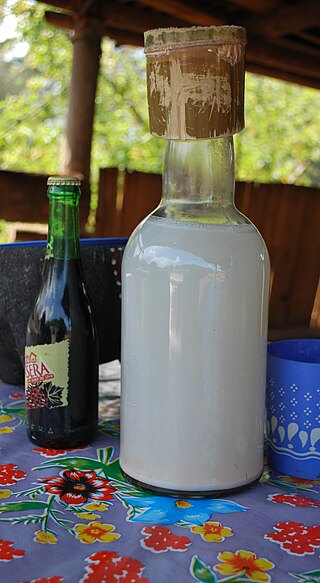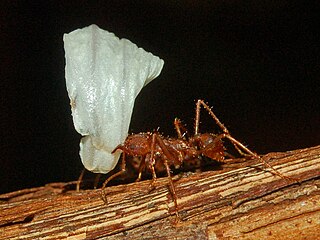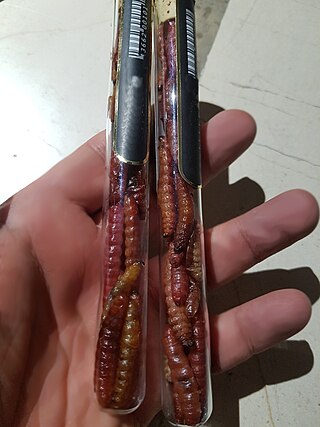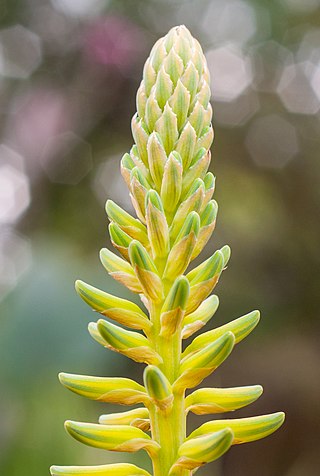
Mezcal, sometimes spelled mescal, is a distilled alcoholic beverage made from any type of agave.

Entomophagy in humans or human entomophagy describes the consumption of insects (entomophagy) by humans in a cultural and biological context. The scientific term used in anthropology, cultural studies, biology and medicine is anthropo-entomophagy. Anthropo-entomophagy does not include the eating of arthropods other than insects such as arachnids and myriapods, which is defined as arachnophagy.

Chapulines, plural for chapulín, are grasshoppers of the genus Sphenarium that are commonly eaten in certain areas of Mexico. The term is specific to Mexico and Central America, and derives from the Nahuatl word chapolin (singular) or chapolimeh (plural).
Jumiles ;, are small stink bugs native to the Taxco region of the state of Guerrero in Mexico. Their diet includes the leaves of the encina tree. Chumiles are a smaller, similar stink bug of the same region. Any edible Hemiptera from the families Coreidae or Pentatomidae may be considered jumiles as well.

Escamoles, known colloquially as Mexican caviar or insect caviar, are the edible larvae and pupae of ants of the species Liometopum apiculatum and L. occidentale var. luctuosum. They are most commonly consumed in Mexico City and surrounding areas. Escamoles have been consumed in Mexico since the age of the Aztecs. The taste is described as buttery and nutty, with a texture akin to that of cottage cheese.

A mezcal worm is an insect larva found in some types of mezcal produced in Oaxaca, Mexico. The larva is a red maguey worm, the caterpillar of the Comadia redtenbacheri moth, usually called chinicuil or gusano rojo. The red worm is typically considered tastier than a white maguey worm.

Aztec cuisine is the cuisine of the former Aztec Empire and the Nahua peoples of the Valley of Mexico prior to European contact in 1519.

Pulque, occasionally known as octli or agave wine, is an alcoholic beverage made from the fermented sap of the maguey (agave) plant. It is traditional in central Mexico, where it has been produced for millennia. It has the color of milk, a rather viscous consistency and a sour yeast-like taste.

Atta mexicana is a species of leaf-cutter ant, a New World ant of the subfamily Myrmicinae of the genus Atta. This species is from one of the two genera of advanced attines within the tribe Attini.

Insects as food or edible insects are insect species used for human consumption. Over 2 billion people are estimated to eat insects on a daily basis. Globally, more than 2,000 insect species are considered edible, though far fewer are discussed for industrialized mass production and regionally authorized for use in food. Many insects are highly nutritious, though nutritional content depends on species and other factors such as diet and age. Insects offer a wide variety of flavors and are commonly consumed whole or pulverized for use in dishes and processed food products such as burger patties, pasta, or snacks. Like other foods, there can be risks associated with consuming insects, such as allergic reactions. As commercial interest in insects as food grows, countries are introducing new regulatory frameworks to oversee their production, processing, marketing, and consumption.

Oaxacan cuisine is a regional cuisine of Mexico, centered on the city of Oaxaca, the capital of the eponymous state located in southern Mexico. Oaxaca is one of Mexico's major gastronomic, historical, and gastro-historical centers whose cuisine is known internationally. Like the rest of Mexican cuisine, Oaxacan food is based on staples such as corn, beans and chile peppers, but there is a great variety of other ingredients and food preparations due to the influence of the state's varied geography and indigenous cultures. Corn and many beans were first cultivated in Oaxaca. Well known features of the cuisine include ingredients such as chocolate, Oaxaca cheese, mezcal and grasshoppers (chapulines) with dishes such as tlayudas, Oaxacan style tamales and seven notable varieties of mole sauce. The cuisine has been praised and promoted by food experts such as Diana Kennedy and Rick Bayless and is part of the state's appeal for tourists.

The welfare of farmed insects concerns treatment of insects raised for animal feed, as food or pet food, and other purposes such as honey and silk.

Comadia redtenbacheri is a moth in the family Cossidae. It is found in North America, where it has been recorded in Mexico and southern Texas.

Maguey worms are either of two species of edible caterpillars that infest maguey plants.

Various cultures throughout Africa utilize insects for many things and have developed unique interactions with insects: as food sources, for sale or trade in markets, or for use in traditional practices and rituals, as ethnomedicine or as part of their traditional ecological knowledge. As food, also known as entomophagy, a variety of insects are collected as part of a protein rich source of nutrition for marginal communities. Entomophagy had been part of traditional culture throughout Africa, though this activity has been diminishing gradually with the influx of Western culture and market economies. Often the collection of insects for food has been the activity of children, both male and female.
Arachnophagy describes a feeding behaviour that includes arachnids. Aside from non-human creatures, the term can also refer to the practice of eating arachnids among humans.

The maguey flower, in Spanish, flor de maguey, also known locally as gualumbo, hualumbo, quiote or jiote is a typical product of Mexican cuisine, cultivated mainly in the rural areas of the center of the country. Due to its difficult availability, it is considered a delicacy. Maguey flowers are harvested and consumed closed, since once opened (ripened), they have a bitter taste.

Entomophagy is the practice of eating insects. An alternative term is insectivory. Terms for organisms that practice entomophagy are entomophage and insectivore.




























